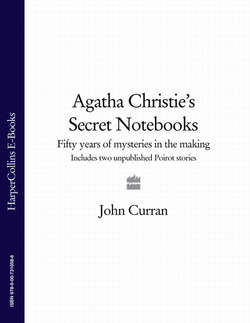Читать книгу Agatha Christie’s Secret Notebooks: Fifty Years of Mysteries in the Making - Includes Two Unpublished Poirot Stories - John Curran - Страница 28
EXHIBIT A: THE DETECTION CLUB
Оглавление’It’s rather early to ring you up but I want to ask you a favour.’
‘Yes?’
‘It is the annual dinner of our Detective Authors’ Club.’
Third Girl, Chapter 2
The Detection Club, as its name suggests, is a club for writers of detective stories. Although the exact date is uncertain, it was probably founded in 1929. Anthony Berkeley and Dorothy L. Sayers were two of the founders and by the early 1930s all of the major writers of detective fiction of the day, including Agatha Christie, were members. Only writers of classical detective fiction, as distinct from crime writers in general, were eligible to join. It was not a professional body campaigning to improve the lot of crime writers; rather it was a glorified dining club with G.K. Chesterton, creator of Father Brown, as its first President, followed in 1936 by E.C. Bentley, author of the famous Trent’s Last Case, and, from 1958 to her death in 1976, Agatha Christie. She agreed to this role on the understanding that she would never have to give a speech. Membership was by invitation only and all new members had to undergo an initiation ceremony (designed by Dorothy L. Sayers), involving the President in ceremonial robes, a procession with candles and the initiate swearing an oath, while placing a hand on Eric the Skull, to uphold the club’s rules.
Although these rules were unwritten and the ritual itself, designed by Sayers, light-hearted, the intentions behind them were serious and admirable. In an effort to raise the literary level of the detective story and to distinguish it from the thriller or ‘shocker’, candidates had to promise:
to honour the King’s English;
never to conceal a vital clue from the reader;
to adhere to detection as distinct from ‘Divine Revelation, Feminine Intuition…Coincidence or Acts of God’;
to observe ‘a seemly moderation in the use of Gangs, Death-Rays, Ghosts, Mysterious Chinamen and Mysterious Poisons unknown to Science’;
never to steal or disclose the plots of other members.
In the early days the Detection Club produced collaborative novels and, in more recent times, short story collections. In the early ventures different hands wrote succeeding chapters, each subsequent writer taking cognisance of the plot developments of his or her predecessor. Agatha Christie contributed to the three earliest publications, The Scoop in 1930, Behind the Screen the following year and the full-length novel The Floating Admiral in 1932. The first two shorter efforts were read in instalments on BBC radio and subsequently published in The Listener, finally appearing in book form in 1983. Apart from Christie, the collaborators on The Scoop were Dorothy L. Sayers, Anthony Berkeley, E.C. Bentley, Freeman Wills Crofts and Clemence Dane; Ronald Knox and Hugh Walpole replaced Crofts and Dane for Behind the Screen.
In the case of The Floating Admiral each contributor had to include a proposed solution as well as a chapter in an effort to prevent complications being introduced merely to make life difficult for the following contributor. Christie’s contribution is, unfortunately, the shortest in the book, but her proposed solution is a typically ingenious one. However, she decided that the time and effort that went into one of these productions could be more profitably spent on her own writing and she politely declined to involve herself in any further titles.
